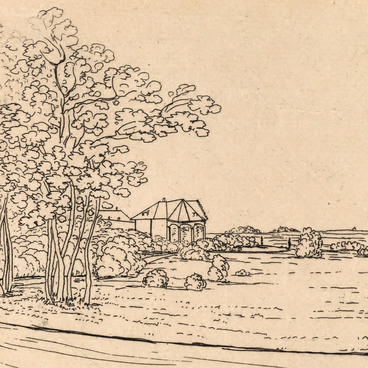Among the items that belonged to the poet YevgEniy Boratynskiy, the collection of the museum lists a dainty desktop folder for papers - a buvard, created in the 1830s. The name ‘buvard’ comes from the French word buvard, which is literally translated as ‘the one who drinks’. In this case it is about ink. The folder is made of embossed skin and has two internal sections.
The blotting books were primarily intended for the storage of blotting paper, which was indispensable in the first half of the 19th century. You had to dry the ink after writing. In addition to blotting paper, the special pockets inside the blotting book contained blank sheets of postal paper, envelopes, postal stamps and other utensils for writing.
Coming to Kazan from Moscow to settle the estate affairs, Yevgeniy Boratynskiy carried on intensive correspondence with friends and shared his impressions. In one of the letters, he described Kazan: ‘I think a provincial city is busier than the capital… In the provinces there is more civic consciousness, more passion, more elements of politics and poetry. I have already seen enough to always prefer a provincial city to the capital as the place of action of the Russian novel’.
The embossing on the blotting book is done in the style of chinoiserie, which is translated from French as ‘Sinicism’. It originated in Europe in the late 17th century, when many countries became fascinated by imported Chinese porcelain and other decorative and applied arts. Europeans embodied in this style their view of ‘mysterious’ China, which was very far from the real state of affairs.
Following the ‘Sinicism’ fashion nobility started decorating their houses with screens, silk wallpaper with exotic designs, mirrors and furniture, porcelain vases and statuettes created in this style. Many nobles wore silk Chinese robes. In the embossing of the folder you can see the characteristic artistic motifs of the style of chinoiserie: songbirds on the branches of blooming plum, pheasants and herons among the branches of bamboo, butterflies flocking to peony in full bloom.
The blotting books were primarily intended for the storage of blotting paper, which was indispensable in the first half of the 19th century. You had to dry the ink after writing. In addition to blotting paper, the special pockets inside the blotting book contained blank sheets of postal paper, envelopes, postal stamps and other utensils for writing.
Coming to Kazan from Moscow to settle the estate affairs, Yevgeniy Boratynskiy carried on intensive correspondence with friends and shared his impressions. In one of the letters, he described Kazan: ‘I think a provincial city is busier than the capital… In the provinces there is more civic consciousness, more passion, more elements of politics and poetry. I have already seen enough to always prefer a provincial city to the capital as the place of action of the Russian novel’.
The embossing on the blotting book is done in the style of chinoiserie, which is translated from French as ‘Sinicism’. It originated in Europe in the late 17th century, when many countries became fascinated by imported Chinese porcelain and other decorative and applied arts. Europeans embodied in this style their view of ‘mysterious’ China, which was very far from the real state of affairs.
Following the ‘Sinicism’ fashion nobility started decorating their houses with screens, silk wallpaper with exotic designs, mirrors and furniture, porcelain vases and statuettes created in this style. Many nobles wore silk Chinese robes. In the embossing of the folder you can see the characteristic artistic motifs of the style of chinoiserie: songbirds on the branches of blooming plum, pheasants and herons among the branches of bamboo, butterflies flocking to peony in full bloom.



